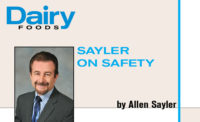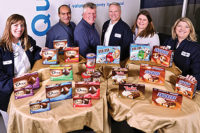
In Transition
by James Dudlicek
Stonyfield Farm expands its Londonderry plant to keep up with product demand.
“Pardon our dust” would be an appropriate sign to post right now at the visitors center at Stonyfield Farm’s plant in Londonderry, N.H.
The 17-year-old facility is in the midst of its latest
expansion, expected to continue for the next couple of years. Corporate
offices that used to share space in the building have been relocated to
temporary quarters on the opposite end of the nearby Manchester-Boston
Regional Airport and replaced with processing and packaging machinery.
It’s appropriate that Dairy
Field’s 2006 Processor of the Year should
be experiencing such a metamorphosis, since it’s a reflection of the
success the company has been experiencing due to its fortunate position in
an organics boom and a continued trend toward health and wellness.
Double-digit annual growth has been the result, and it
has kept Stonyfield’s operations team hopping.
“Two years ago, we were a two-shift production
plant, five days a week. When we needed more, we just pushed a bit into the
night or on Saturday and Sunday,” explains Stephane Lacroix, vice
president of manufacturing. “The first thing we did was to move to a
real three-shift system. We can now do both CIP and production on every
shift. That increased the capacity quite a lot.”
These changes were aided by modifications made in the
processing area using the latest technology approved by the Pasteurized
Milk Ordinance, Lacroix says. “The next step was adding some capacity
on the drink side for our smoothies. That was a major project; we added a
filler and fermentation capacity,” he continues. “All of that
was still not enough to fulfill the demand. So what we did then was to move
to a seven-day, 24-hour system to improve the customer service
level.”
In the meantime, Lacroix’s team was designing the
plant expansion. “This expansion is now coming to life. The first
step last spring, within the existing walls, we basically moved all our
filling and packing equipment into an area to make the expansion possible
and give us more space for processing equipment needed,” he says.
Diane Carhart, chief operating officer, puts the
project in context. “Before we started the expansion, we were
thinking our capacity was limited to 70,000 tons a year. What we’re
trying to do in the phases we’ll be completing in 2007 is to bring
the plant to almost double that in potential capacity,” she says.
“In order to do that, we had to move the lines so we could add
additional filling lines, but also make room for processing and install an
entirely new processing and CIP system, which was a huge
project.”
Lacroix says the plant’s new centralized CIP
station was a huge improvement, both in terms of quality and productivity.
“We’re actually adding two CIP stations that are both high
capacity and centralized. Process automation is certainly one of the big
drivers of productivity, and we’re going to a fully automated
process. The goal is to not only remove as many flow panels as possible and
replace them with valve clusters, but also to continue to use batches that
are as large as possible,” he says.
“Until now, we had very limited CIP capacity. It
was a capacity bottleneck. What we’re doing at the moment is getting
rid of these constraints by having much more capacity on the cleaning
side.”
Plant Evolution
Jeff Presby, plant quality services manager, leads our
tour through a plant in transition, noting new areas in operation and
others still waiting to come on line.
Among them is a new, larger raw-receiving area that was
still a few months away from being commissioned during our late-September
visit. The plant currently averages about nine daily tanker deliveries.
With a current maximum of a dozen 6,000-gallon trucks per day, the new
receiving bay will allow twice that, explains process engineer Andrew
Kilar. “This will give us capacity to grow,” he says.
Once the new receiving bay is up and running, the old
one will be demolished to make way for a new bulk powder and blending room
to handle deliveries of organic milk powder, inulin and other dry
ingredients. Bulk-sugar handling improvements are expected to follow in
2007.
The new pasteurized CIP system will feature five tanks
at 7,200 gallons each plus 10,000 gallons of process water, Presby says; a
new raw CIP system will bring four tanks at 4,200 gallons each.
A new batching area is under construction in a new
addition to the structure. The old blending room — woefully
undersized for the plant’s evolving needs — will eventually be
used only for soy products to ensure that allergen’s segregation from
the other production areas.
Raw milk is cultured, chilled and reheated before it
gets to the fillers. Presby says Stonyfield’s filling and packaging
lines can deliver 1,700 cases per hour of 4-ounce cup yogurts, 3,300 for
6-ounce cups, 1,200 for 32-ounce containers and 1,600 cases of 6- and
10-ounce drinks, for a total of more than a half million cases per week.
In the packaging room (formerly the chill-cell area),
cup yogurt gets stacked on cardboard flats that are formed into 12- or
24-count boxes; 32-ounce packages are loaded into cases of six. Finished
products are sent on a heated conveyor to be palletized; Presby explains
that pallets are also heated to avoid premature chilling.
Palleted product goes into a cooling tunnel. With two
100-foot tunnels currently in service and a third on the way, each tunnel
can hold 20 to 25 pallets of yogurt. The tunnels replace the chill-cell
system formerly used.
Except for smoothies, all Stonyfield yogurt is cup-set,
or incubated after packaging. Live cultures are activated over several
hours in the incubation room at temperatures in excess of 100 degrees F.
With a 90-pallet capacity at present, the incubation room will be able to
hold “well over 100” pallets after racks are installed, Presby
says.
A new cold warehouse, complete with shrink-wrap
turntable, can hold up to 4,200 pallets. A previous expansion of the cooler
now serves as a dry ingredients warehouse.
Being Green
Stonyfield Farm’s commitment to the environment
extends well beyond its corporate giving and packaging messages. At the
plant, rooftop solar panels and a high-tech wastewater treatment system
show the company practices what it preaches.
“We wanted to find a system which can treat our
effluence in a good way, which is not only to have good effluence to city
sewers but also to reduce the amount of sludge produced,” Lacroix
explains. “We decided use an anerobic system, which is very efficient
from an energy standpoint, since we are producing methane that is used to
warm our effluence, which makes the system even more efficient.”
Lacroix says that’s huge in terms of sludge
reduction, which eases the burden on the local municipal sewer system. In
addition to generating all the energy it needed to run, the plant produces
barely a truckload of waste every two to three years, versus the monthly
output of more conventional facilities. “It’s almost a
zero-sludge production system,” he says. “It was slightly
higher in investment, but very much worthwhile in terms of the payback,
both from a cost standpoint and an environmental standpoint.”
Nancy Hirshberg, vice president of natural resources,
adds: “It would have been cheaper to not install that, but we went
the extra mile to install it because it’s really important to
us.”
Somewhat less impactful but hardly less important to
Stonyfield are the solar energy collection panels on the roof of the plant.
The largest such panel array in New Hampshire and among the largest in New
England, it supplies 1 percent of the plant’s electricity.
Quality, Naturally
Lacroix says the company is moving toward more
form-fill-seal technology like that used on its YoBaby line of yogurt for
infants, sold in multipacks. “We’ve equipped those machines
with laminar flow systems, which deliver a very high quality of air in the
dosing area where the product is exposed and so is a very good safety net
for airborne contamination. Those machines are also equipped with
foreign-body prevention systems,” he says. “So they’re
not only high-efficiency and high-productivity machines, they are also
high-quality machines that deliver better-quality product.”
For Stonyfield, delivering better-quality products
also means holding itself to a higher standard than mandated by regulatory
requirements. “We make the most traditional and purest yogurt and
cultured products as defined in the sense of how they are designed and
manufactured. In terms of quality of design and quality of execution,
they are the most traditional, natural and organic yogurt and cultured
products made anywhere,” says Kasi Reddy, senior vice president,
quality and food safety, R&D, Stonyfield affiliates, who has operations
oversight for Stonyfield and Brown Cow products manufactured at eight
company-owned and contract-manufacturing locations.
“In addition to mandated regulations, we adhere
to long-held, self-imposed practices that reflect our corporate philosophy,
company mission and long-range objectives. For example, we do not use
modified food starches, gelatins and any other artificial additives. In
addition, we have rBST-free compliance for milk where we pay a premium to a
farmer to provide BST-free milk. We have pretty extensive allergen control
compliance. We have a very comprehensive and broad range of quality, food
safety and crisis management programs for all locations, and we also have a
team that oversees corporate quality and food safety for all eight
locations.”
One might think that with such stringent standards,
post-9/11 regulations would not present much of a hardship for Stonyfield
operations.
“I think, even for us, we have had to take many
more additional measures than the overkill we felt we were taking ”
Reddy says. “So as we build the new plant, we continue to capitalize
on any and all opportunities to both improve and implement new quality,
food safety and security systems, to make sure we’re being protected
to the maximum.”
In all, improvements to streamline operations are seen
as going hand in hand with efforts to ensure quality and a consistent
product. “I don’t make a difference between quality and
productivity,” Lacroix says, “because I strongly believe those
two go together.”
Stonyfield Farm’s At a Glance
Location: Londonderry,
N.H.
Year opened: 1989,
with expansion ongoing.
Size: 160,000 square
feet.
Employees: 258
in operations, 374 total.
Products made: Organic
yogurt and smoothies.
Capacity: 565,000
cases weekly.
Processing: HTST
4,400 gallons per hour currently, to 10,000 in 2007.
Filling: One 4-ounce
line, three 6-ounce lines, one 32-ounce line and one drink line (6- and
10-ounce).
Storage: 4,200 pallet
spaces in cold warehouse.
$OMN_arttitle="In Transition";?>

